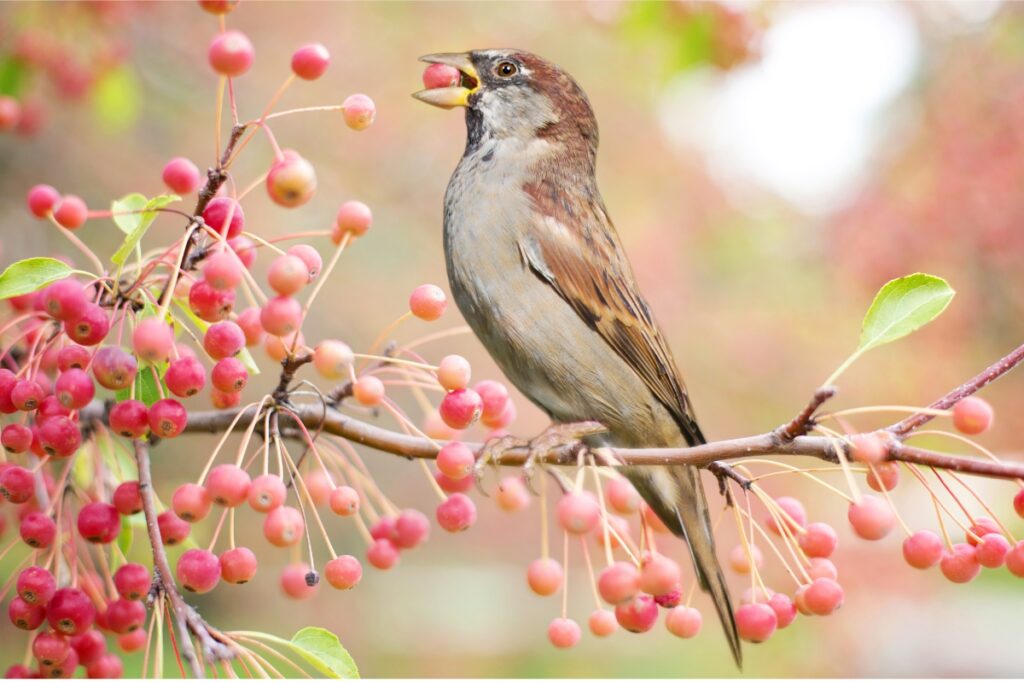As an Amazon Associate, we earn from qualifying purchases with no additional costs for you.
Birds form an important part of ecosystems and food webs. Birds may help pollinate plants, control the numbers of invertebrates, and spread the seeds of fruits.
Birds play a vital role in spreading the seeds of berries. When birds eat berries, they digest the flesh but pass the seeds through their droppings. Seeds are scattered across different locations, promoting plant growth and biodiversity and aiding the propagation of berry-producing plants.
Read on to learn more about how birds spread berries and other types of seed dispersal methods. You will also learn about the types of berries birds eat and which types of birds feed on berries.
TIP: If you want to check out the best pair of binoculars for bird watching, we recommend a pair of waterproof and fog-proof 8 x 42 binoculars like the Celestron – Outland X 8×42 Binoculars (Amazon link).
How Do Birds Help Spread The Seeds Of Berries?
Birds help spread the seeds of berries and fruits when they eat them or drop them on the ground. Depending on the type of berry, the bird may consume the entire fruit. The seed of the fruit is then passed out in the droppings of the bird. At the same time, the seed is surrounded by natural fertilizer in the bird’s feces.
Birds will eat a berry and fly off, only to defecate later somewhere else. This provides a new place for the seed of the plant to germinate.
Although the seed may not always be dropped in a place conducive to germination, the process works well much of the time. The plants lure birds and other animals by producing brightly colored and tasty berries.
The relationship can be close, for instance the Mistletoebird and the Mistletoe plant. The bird is carefully adapted to specialize on fruit, to eat and disperse the seeds of the plant.
Watch this interesting video of Misteloebirds spreading seeds of the Mistletoe plant!
Seed Dispersal Mechanisms
There are a number of ways that plants can spread their seeds. The various methods of seed dispersal are as follows:
Abiotic Methods
- Explosion: Some plants such as peas and lupines, produce seeds in long pods. When the pods are fully ripe, the pods burst open and the seeds are flung out. This is an explosive method of seed dispersal that does not rely on any animals.
- Wind: Wind dispersal works well if the plant produces very light seeds that can be easily picked up and carried aloft on even small breezes. The classic example most of us are familiar with is the dandelion. If you blow on a dandelion plant with a seed head, you will see the seeds easily fly off. It is possible that an animal bumping into a dandelion inadvertently helps the process along, but it is the wind that disperses the seeds.
- Water: Water dispersal is primarily a mechanism that works for plants that grow close to or actually in water. Plants like rushes and waterlilies use this method to disperse their seeds when ready.
- Gravity: Several plants simply use gravity and the seed falls on the ground. This happens in plants that produce seeds surrounded by a fleshy fruit. Examples of plants that use this strategy include coconuts, apples, and passion fruit. The fruits drop to the ground and rot, releasing the seeds. Sometimes, animals do also eat the fruits and help disperse the seeds.
TOP TIP: Many birds eat other seeds, like sunflower seeds. Read this ultimate guide to discover which birds eat sunflower seeds. Should you feed wild birds in winter, and if so, what should you feed them? Find out all you need to know in this article.
Biotic Methods
- Animals: Various animals (including birds) help disperse seeds. Some seeds have hooks or barbs to attach to the fur or feathers of animals. Cocklebur is a plant that produces seeds that have spines that catch on to animal fur. It is hard for the animal to remove the seeds and thus, the seeds are carried some distance from the original plant.
Seeds enclosed in fruits (including berries) are eaten by birds and mammals like bats and monkeys. The seeds are dispersed when they pass through the animal’s digestive tract and are defecated out. The animal may also drop the fruit on the floor, dispersing the seeds in that way.
Birds feed on berries but also on bigger fruits like papaya or apples in parts of the world where these fruit trees are grown.
TIP: Are you looking for high-quality food for wild birds on your backyard? I recommend using Wagner’s products with the highest quality grains used in blending and made in the USA (Amazon links):
– Deluxe Treat Blend Wild Bird Food
– Eastern Regional Wild Bird Food
– Western Regional Wild Bird Food
– Midwest Regional Wild Bird Food
– Southern Regional Wild Bird Food
The Types Of Berries Birds In North America Eat
There are many berry-producing plants in North America that provide food for birds and other animals. Myrtle, hawthorn, pyracantha, holly, viburnum, and juniper are all plants that are known to produce berries that are fed on by birds in the United States.
This video is of Robins eating American Holly berries – what a feast!
Bird Species That Feed On Berries In North America
Various birds will eat berries either year-round or in winter when other foods are scarce. Birds that do feed on berries include the robins, thrushes, woodpeckers, warblers, mockingbirds, thrashers, and waxwings.
Cedar Waxwings occur in flocks that arrive to feed on the berries of plants. Watch this video to see them at work.
Birds That Feed On Berries Elsewhere In The World
There are bird species found in other parts of the world that eat berries. These birds include mousebirds, bulbuls, white-eyes, and mynahs, along with the local thrushes and robin chats.
These birds will also feed on other fruits, such as papayas. Some weavers and canaries also eat fruit since many of these birds are omnivorous, feeding on various food items they can find.
To discover if Lantana berries are good for White-eyes to eat, watch this video!
Conclusion
Birds play an important role in seed dispersal by feeding on berries. Seeds in the berries pass through the bird’s gut and out with their droppings.
This is how seeds are dispersed. Another way is if the bird drops the fruit on the ground and it rots, releasing the seeds. Birds may also disperse other types of seeds that stick to their feathers when they pass by.
TIP: Check out my recommended products if you are looking for the best and trusted equipment for birdwatching in the wild or on your backyard (Amazon link):

